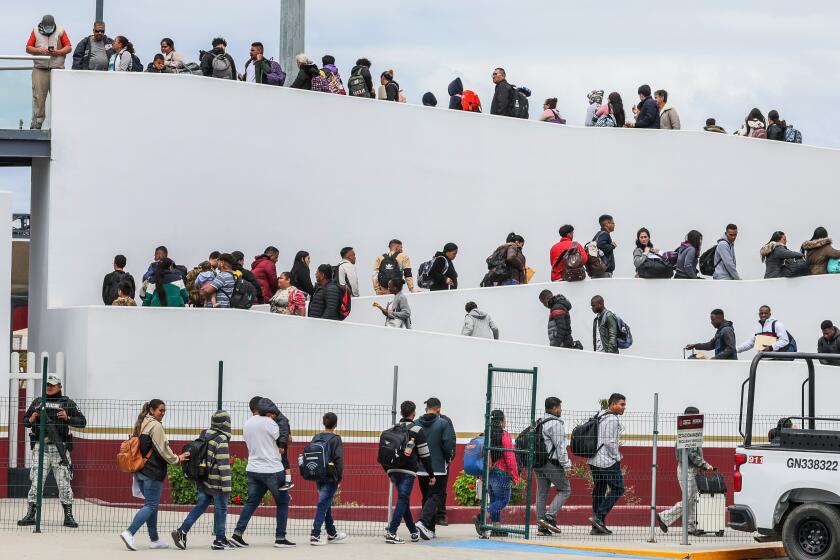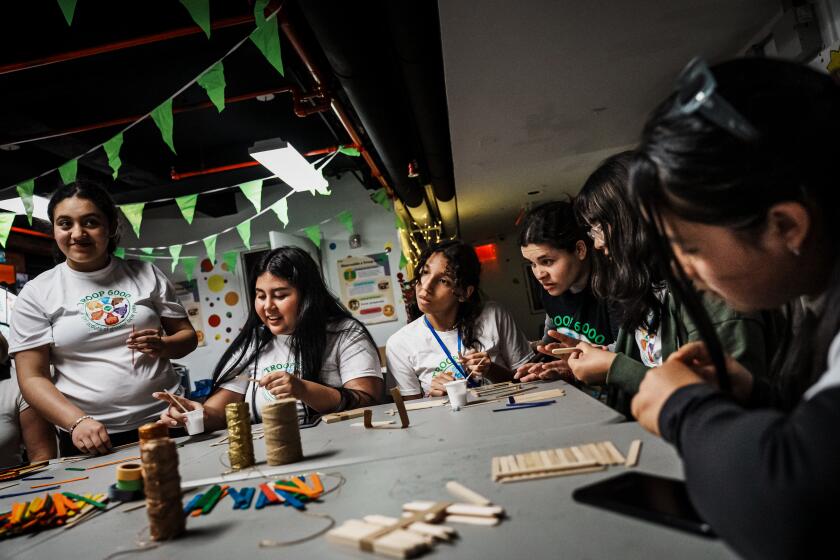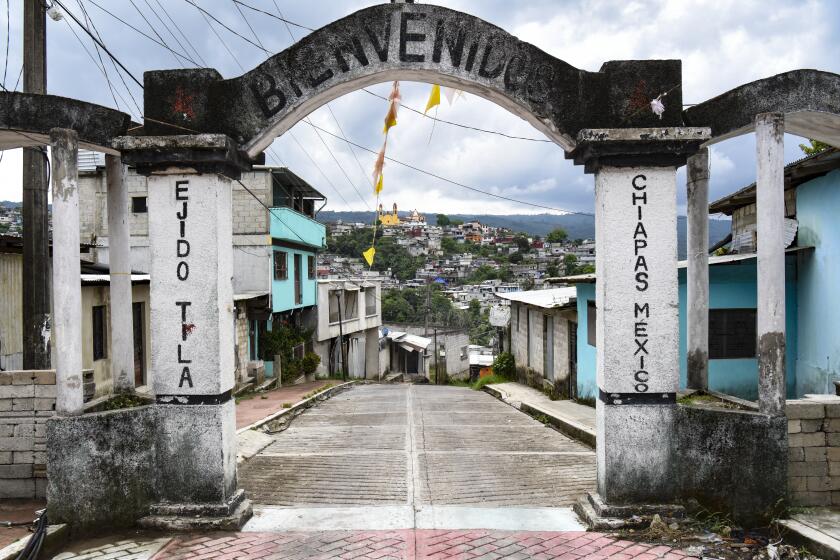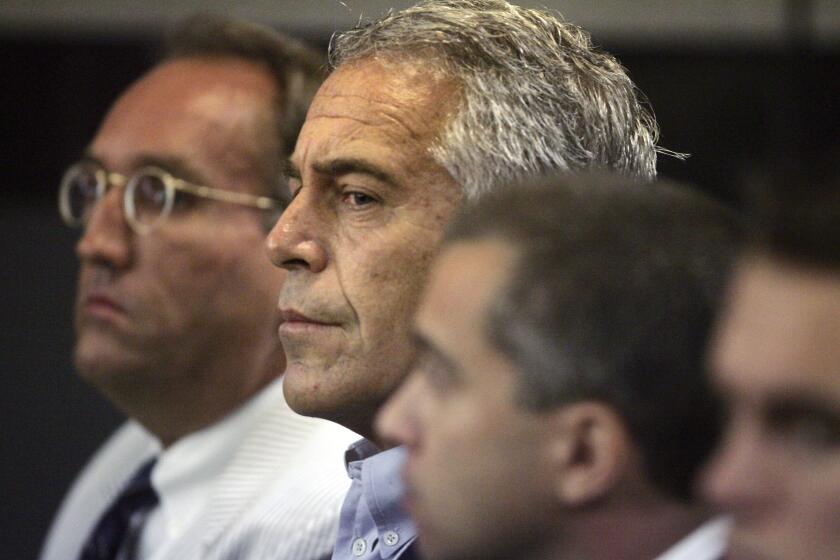U.S. expands area in Mexico to apply for border asylum appointments, hoping to slow push north
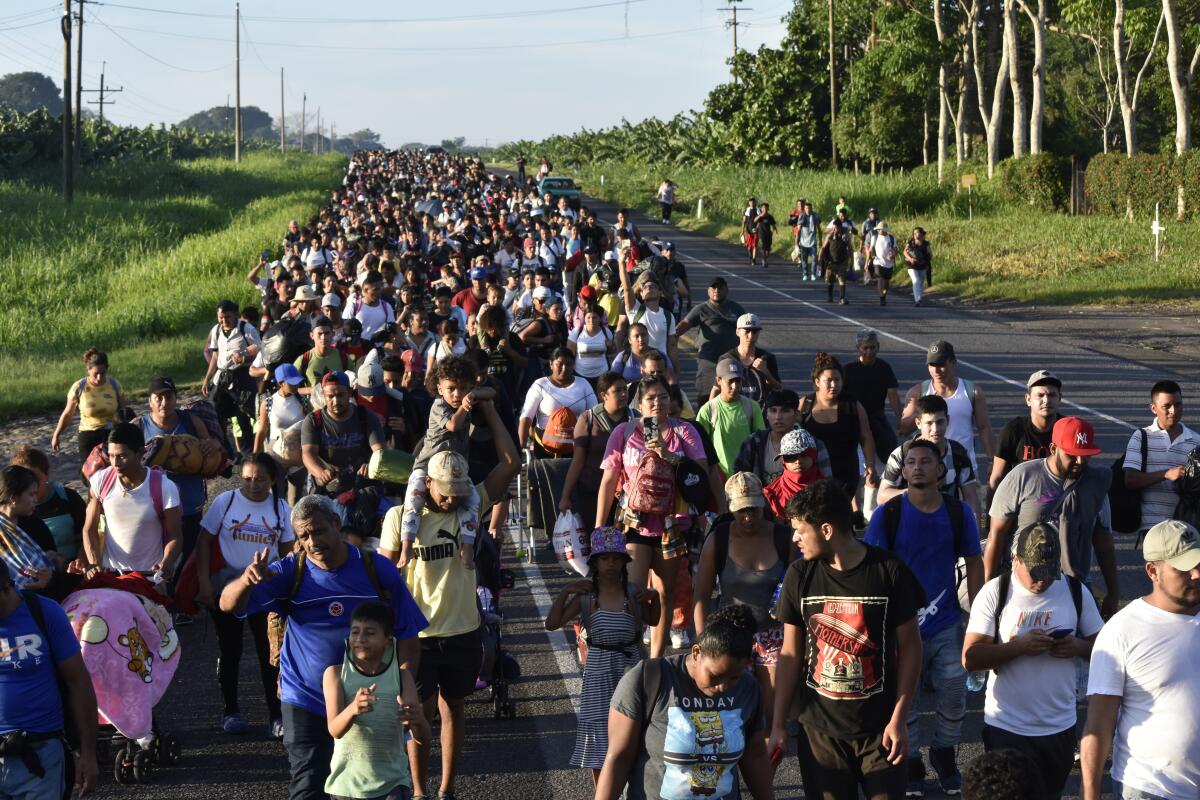
- Share via
CIUDAD HIDALGO, Mexico — As soon as she stepped onto Mexican soil this week, Venezuelan migrant Yuri Carolina Meléndez downloaded the U.S. government’s app to apply for asylum appointments.
The CBP One app has been around, but as of Friday migrants in Mexico’s southernmost states bordering Guatemala will be able to apply for appointments. Previously, they had to be in central or northern Mexico.
“I have to wait to see if it really works,” Meléndez said while resting under a tree with her 16- and 18-year-old daughters along a border highway leading to the city of Tapachula this week.
Mexico has been asking the U.S. to expand the app’s access to the south in an attempt to relieve the pressure migrants feel to continue north to at least Mexico City. In recent years, the Mexican government has tried to contain migrants in the south farther from the U.S. border, but the lack of work opportunities and housing in southern cities like Tapachula have pushed migrants north.
Mexico hopes that if migrants can wait for their appointments in the south, they might be at less risk of being preyed on by organized crime groups.
Germin Alemán, a 31-year-old from Honduras traveling with his wife and three children, planned to register as soon as they reached Tapachula. “We’re going to apply here. We’re going to wait for the appointment,” he said as they walked from the border toward Tapachula.
Depending on whom you ask, the federal immigration app CBP One is a solution to the border crisis, a human rights violation or a ploy to let anyone into the U.S.
Others, however, still felt the pressure to get farther north. Many migrants carry big debts and need to start paying them off as soon as possible. Meléndez, for instance, said she planned to keep moving to improve her chances of finding work.
CBP One has been one of the measures of greatest impact in U.S. efforts to bring order to the growing demand for U.S. asylum along its southwestern border. In the 2023 fiscal year, U.S. Customs and Border Protection reported more than 2.4 million encounters with migrants along the border.
Since the app was launched in January 2023, more than 765,000 people have scheduled appointments to request asylum. Immigration is a central issue in the U.S. presidential election.
When the Biden administration in June temporarily suspended the asylum process for those who crossed illegally, the app became one of the only ways to request asylum. The U.S. handles 1,500 appointments daily.
The number of migrants crossing the U.S. border illegally has fallen significantly since the peak in December 2023. The administration attributes much of that decline to Mexico’s enforcement efforts, which include catching migrants in the north and sending them south again.
The Girl Scouts in this troop, in one of New York’s emergency migrant shelters, know hardship and loss. But at meetings at least, they get to be kids.
Still, Mexico welcomes CBP One’s expansion.
“That is going to help us a lot,” Foreign Affairs Secretary Alicia Bárcena said this month when she announced the expansion was coming. Immigration is a key issue in the U.S.-Mexico relationship.
But for dozens of nongovernmental groups that advocate for migrants and human rights, there is little to celebrate.
In an open letter to the Mexican government Thursday, they called CBP One “a violation of international law” because it allows the U.S. to limit access to its territory for people in need of protection.
The groups argued that many migrants wind up stuck in Mexico for months waiting in full shelters or camping in unsanitary conditions. While they wait, they are vulnerable to kidnapping, sexual assaults, torture and extortion by criminals and authorities, the groups said.
In theory, Mexico’s National Institute of Migration allows migrants with CBP One appointments to travel freely to the U.S. border, but the organizations said authorities still sometimes detain migrants and send them south again to keep them from the border.
The institute did not respond to a request for comment about those allegations.
An escalating turf war engulfing much of Mexico’s heavily Indigenous Chiapas state has displaced thousands as gangs battle for drug- and gun-trafficking routes.
In southern Mexico, migrants have always been targets of smugglers and criminals, but the region was quite peaceful for the rest of its inhabitants. Now the situation has changed. The southern border region is locked in a territorial struggle between Mexico’s most powerful drug cartels, which want to control routes for smuggling drugs, weapons and migrants. Violence is part of daily life in a lot of border towns.
Among migrants waiting in Ciudad Hidalgo’s central plaza near the Suchiate River that divides Mexico and Guatemala, the question remains whether to wait or to keep moving north.
As a group of migrants debated the answer, the factor that weighed most heavily was money. The migrants had heard the chances of finding jobs are higher in central and northern Mexico, and money is needed for what could be a months-long wait for an appointment.
“If there are work opportunities, we’ll stay. If not, we’ll keep advancing until they give us an appointment,” said Yuleidi Banqué, a 28-year-old Venezuelan who had just arrived in Mexico with her partner and her 7-year-old daughter.
“My daughter isn’t well. … She’s fed through a feeding tube. We need help,” Banqué said.
The Office of the United Nations High Commissioner for Refugees, known as UNHCR, is cautious about CBP One’s expansion.
Giovanni Lepri, the Mexico chief for UNHCR, said it could mean fewer risks for migrants headed north. But he added that dealing with migration requires diverse measures, “those like stabilizing the countries of origin, protection in the transit countries and options for regularization and asylum in destination countries.”
For Noemí Ramírez, a 47-year-old from El Salvador, hearing that she could begin her asylum application from Mexico’s Chiapas state led her to set off immediately for Tapachula with her 19-year-old daughter.
“We’re going to wait until we get an appointment. I’m not thinking of going any farther,” she said as they walked, worrying about the violence they could face along the way. “I’m not going to risk it with my daughter. We’re alone.”
Associated Press writers Clemente reported from Ciudad Hidalgo and Verza from Mexico City.
More to Read
Sign up for Essential California
The most important California stories and recommendations in your inbox every morning.
You may occasionally receive promotional content from the Los Angeles Times.
